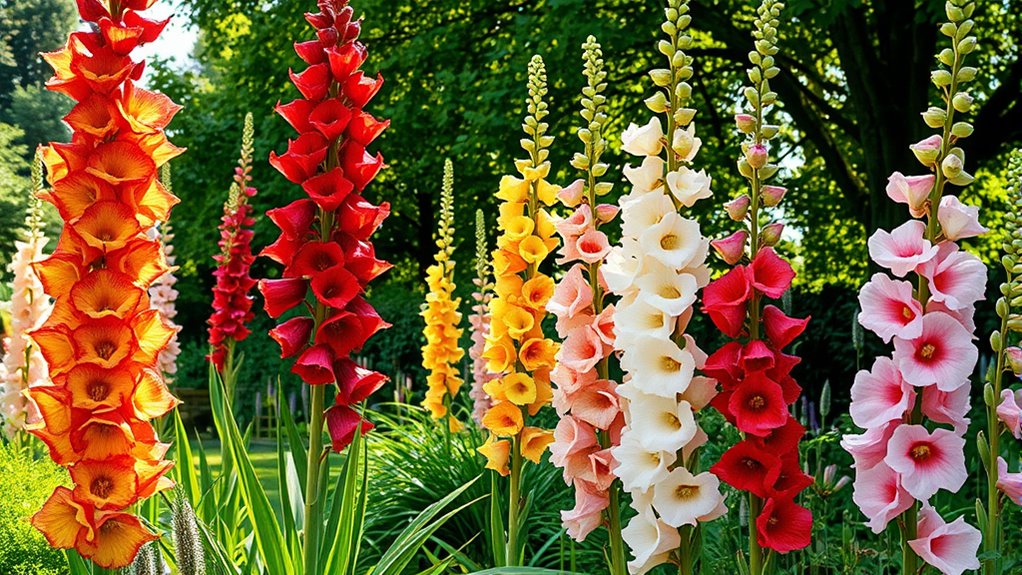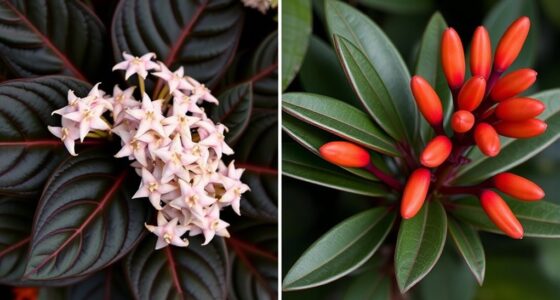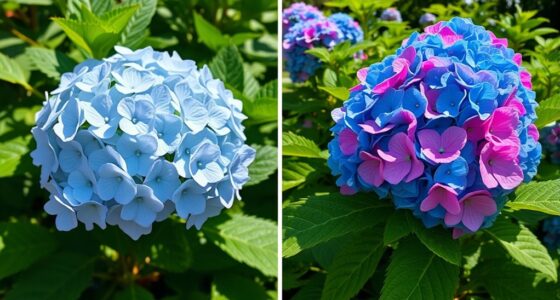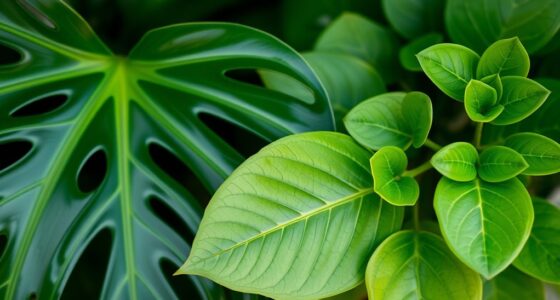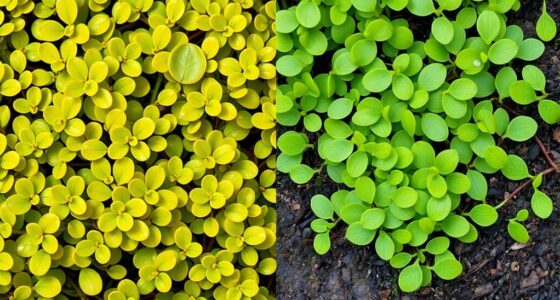Hollyhocks and gladiolus are classic cottage garden favorites, each with unique charms. Hollyhocks grow tall with large, layered blooms in summer, creating vertical interest and a relaxed feel. Gladiolus features slender, trumpet-shaped flowers on shorter spikes, blooming in late spring to early summer for quick bursts of color. Both need well-drained soil and proper spacing, but their distinct appearances and blooming times let you tailor your garden style. Explore more to find out how to make them thrive together.
Key Takeaways
- Hollyhocks are tall, multi-flowered spikes blooming in mid to late summer, while gladiolus feature shorter, tubular blossoms in late spring to early summer.
- Hollyhocks prefer rich, well-drained soil and thrive in back garden borders, whereas gladiolus favor sandy loam and suit middle or front garden spots.
- Hollyhocks are propagated by seed or root cuttings with a longer growth cycle, while gladiolus are grown from corms with a quicker flowering process.
- Hollyhocks have broad, rough leaves and a cottage garden charm, contrasting with gladiolus’s narrow, smooth leaves and architectural vertical lines.
- Both plants attract pollinators but require pest and disease management; they complement each other for continuous garden color.
Visual Appeal and Flower Form
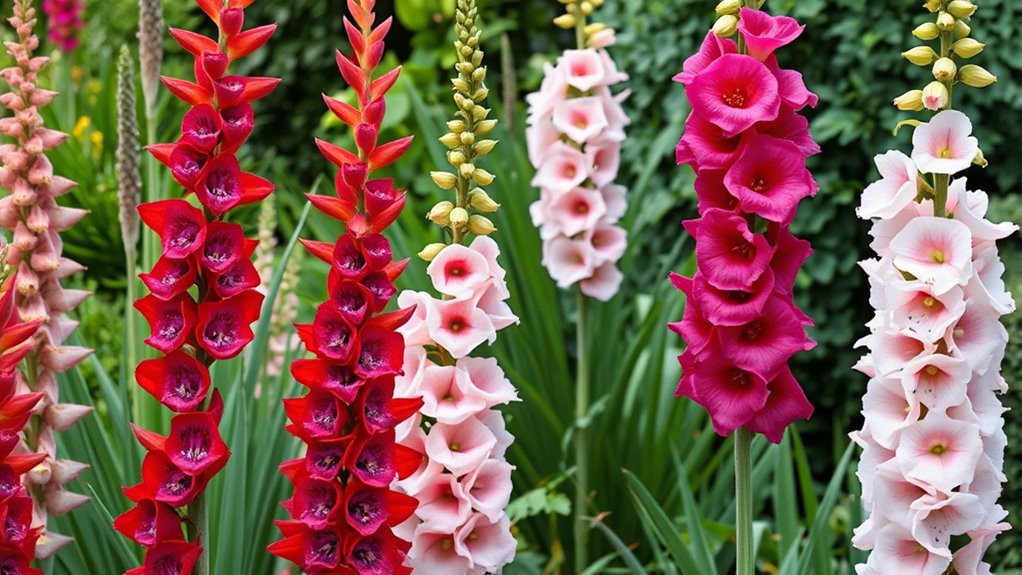
When comparing the visual appeal and flower form of hollyhocks and gladiolus, it’s clear that each offers distinctive charm. Hollyhocks create a wildflower pairing with their tall, spiky clusters of large, rounded blooms that evoke a cottage garden feel. Their soft, layered petals add a charming, vintage touch. Gladiolus, on the other hand, presents a more structured form with slender flower spikes bursting with tubular, trumpet-shaped blossoms. Their vertical, symmetrical arrangement provides a striking contrast. Both flowers contribute to color harmony in your garden, but hollyhocks lend a more relaxed, natural look, while gladiolus offer a bold, architectural statement. Their unique forms and visual appeal allow you to craft diverse, vibrant displays tailored to your garden’s personality. Additionally, incorporating self watering plant pots can help ensure these flowers receive consistent moisture, promoting healthy growth and vibrant blooms. Proper watering techniques are essential for maximizing their flowering potential, especially during dry periods. Furthermore, understanding plant care can enhance your garden’s overall health and aesthetic appeal.
Blooming Seasons and Duration
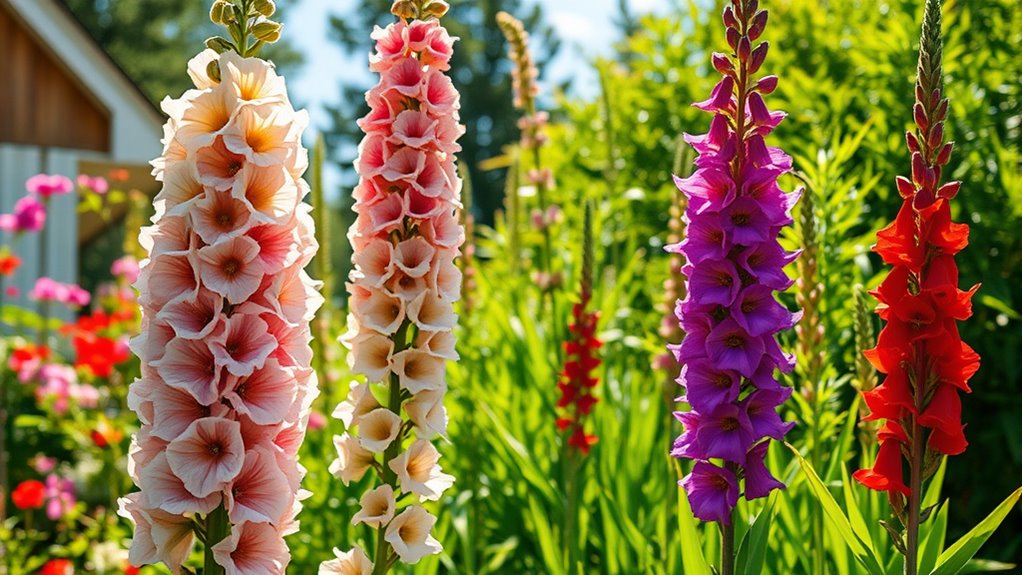
You’ll notice that hollyhocks and gladiolus bloom at different times of the year. Hollyhocks usually flower in summer, while gladiolus often bloom in late spring to summer. Their flowering durations also vary, so understanding these differences helps you plan your garden better. Additionally, selecting diverse planting options can extend your garden’s visual interest throughout the growing season. Incorporating automation in gardening techniques can also help monitor and optimize flowering times for a more vibrant display. Using proper soil conditions can further enhance the health and blooming potential of both plants.
Blooming Times Differ
While hollyhocks typically bloom from mid-summer to early fall, gladiolus generally flower in late spring to early summer. This difference means you’ll enjoy hollyhocks later in the season, often providing color when many other plants have finished blooming. Hollyhocks produce tall spikes with large, showy flowers that have a mild flower fragrance, while gladiolus blooms are more fragrant and appear in vibrant, diverse colors. Their leaf textures also differ: hollyhocks have coarse, rough leaves, whereas gladiolus leaves are smooth and sword-shaped. If you’re planning a garden for extended bloom times, these timing differences can help you stagger your plantings. Knowing when each blooms allows you to create a continuous display of color, filling your garden with life throughout the seasons. Understanding bloom periods can help you optimize your garden’s visual appeal, especially by considering the blooming seasons and duration, which are influenced by planting timing and climate conditions.
Flowering Duration Varies
Hollyhocks and gladiolus differ considerably in how long they bloom. Hollyhocks typically flower for a longer period, often lasting several weeks in late summer, with their tall stalks displaying vibrant flower colors like pink, red, or white. Gladiolus, on the other hand, usually have a shorter blooming window, often about two to three weeks, with their striking flower colors ranging from deep purples to bright yellows. The leaf textures also vary: hollyhocks have broad, rough leaves, while gladiolus leaves are narrow and smooth. This difference influences not only their appearance but also how they fit into your garden’s design. If you want continuous color, hollyhocks may serve you better, but gladiolus can provide quick bursts of lively color. Additionally, flowering duration varies significantly between the two, making each suitable for different garden planning strategies. Understanding the blooming seasons of these plants can help gardeners plan their planting schedules more effectively, especially considering their different growth habits and environments.
Growing Conditions and Soil Preferences
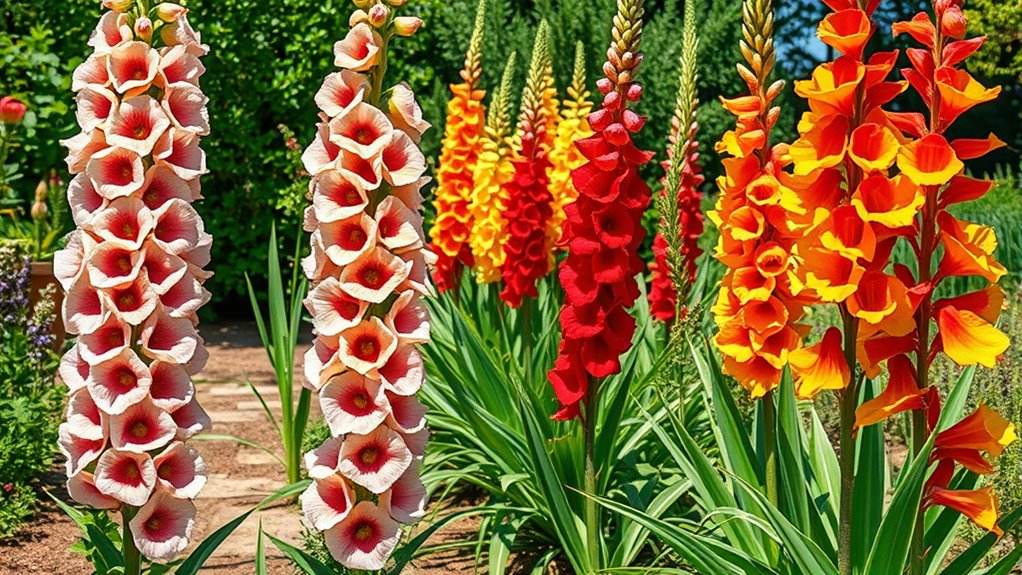
Hollyhocks thrive in well-drained, fertile soils with plenty of organic matter, making them ideal for sunny garden spots. They prefer slightly alkaline to neutral soil pH, but can tolerate a range of soil acidity. To keep them healthy, guarantee consistent watering, especially during dry spells, but avoid overwatering, which can lead to root rot. Gladiolus, on the other hand, prefers well-drained, sandy loam with moderate fertility. They need regular watering during their growth period but dislike soggy soil. Both plants benefit from good drainage to prevent disease. While hollyhocks tolerate a broader pH range, maintaining proper soil conditions and appropriate watering frequency will support vigorous growth and abundant blooms for both. Additionally, using high-efficiency solar panels can provide sustainable energy for garden lighting and small outdoor appliances, enhancing your cottage garden experience. Proper soil preparation and soil enrichment practices help ensure healthy growth and vibrant flowering for these cottage garden classics, and experimenting with creative gardening techniques can further enhance their beauty.
Height, Spread, and Garden Placement
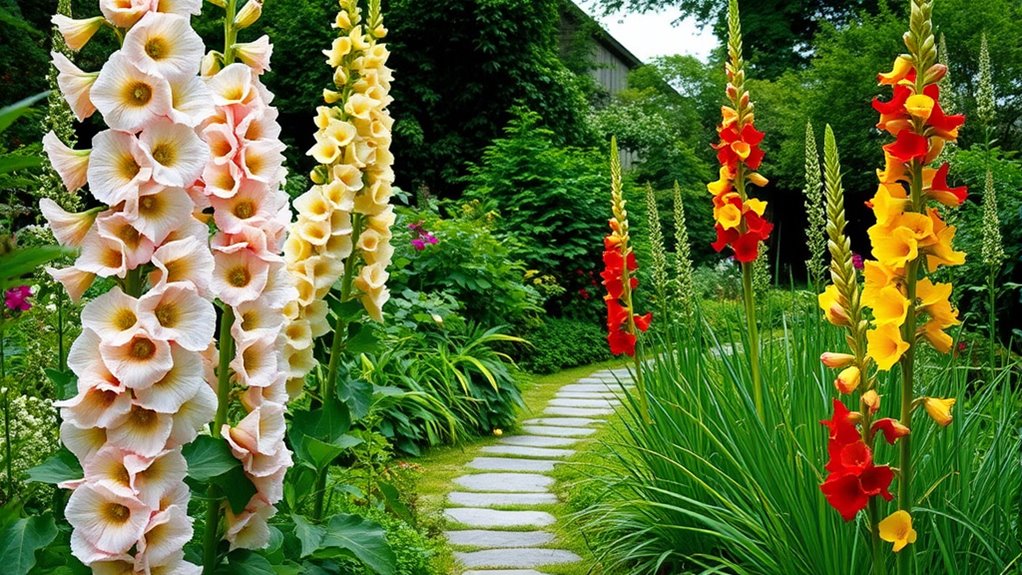
Hollyhocks and gladiolus vary considerably in height and spread, influencing where you should plant them in your garden. Hollyhocks grow tall, often reaching 6 to 8 feet, so they suit the back of your garden layout, providing vertical interest and privacy. Gladiolus, on the other hand, are shorter, typically 2 to 4 feet, making them ideal for middle or front borders. Their spread is usually narrow, so they don’t require much space between plants. Consider scent profiles when placing them; hollyhocks have a subtle, old-fashioned aroma, perfect for quiet corners, while gladiolus have minimal scent, allowing their visual appeal to take center stage. Proper placement maximizes their visual impact and complements your overall garden design. Additionally, understanding their light requirements can help ensure healthy growth and vibrant blooms.
Maintenance and Care Routines
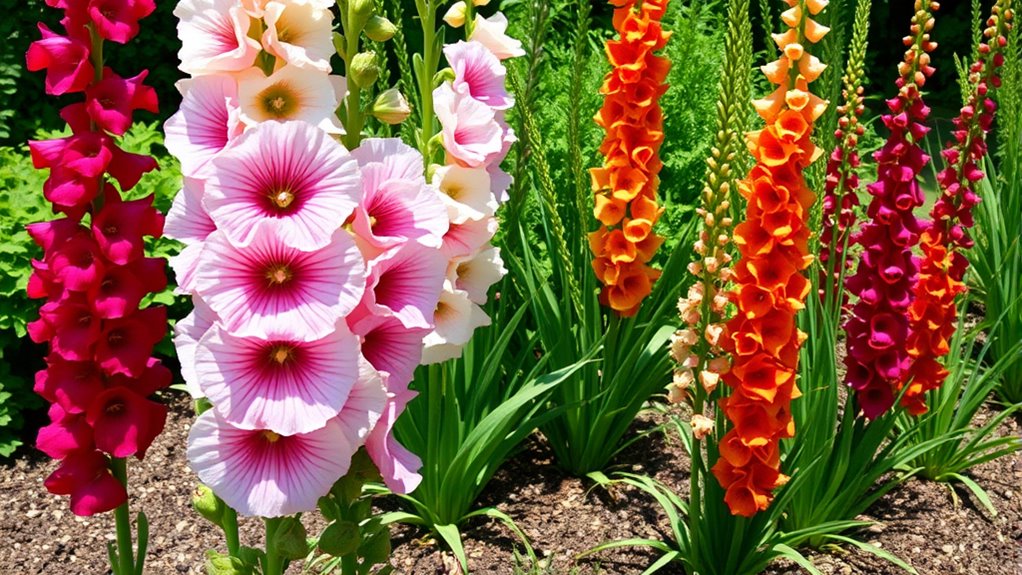
To keep your hollyhocks and gladiolus healthy and vibrant, you’ll need to establish effective maintenance routines. First, consider your garden layout; make certain each plant has enough space for air circulation to prevent disease. Second, regularly water deeply, especially during dry spells, but avoid overwatering to prevent root rot. Third, practice companion planting by pairing your flowers with beneficial herbs or plants that deter pests and enhance growth.
Maintain a neat appearance by staking taller hollyhocks and removing spent flowers from gladiolus to encourage new blooms. Mulch around plants to conserve moisture and suppress weeds. Consistent care tailored to each plant’s needs helps sustain their vitality and ensures your cottage garden remains colorful and healthy.
Propagation Methods and Growth Cycle
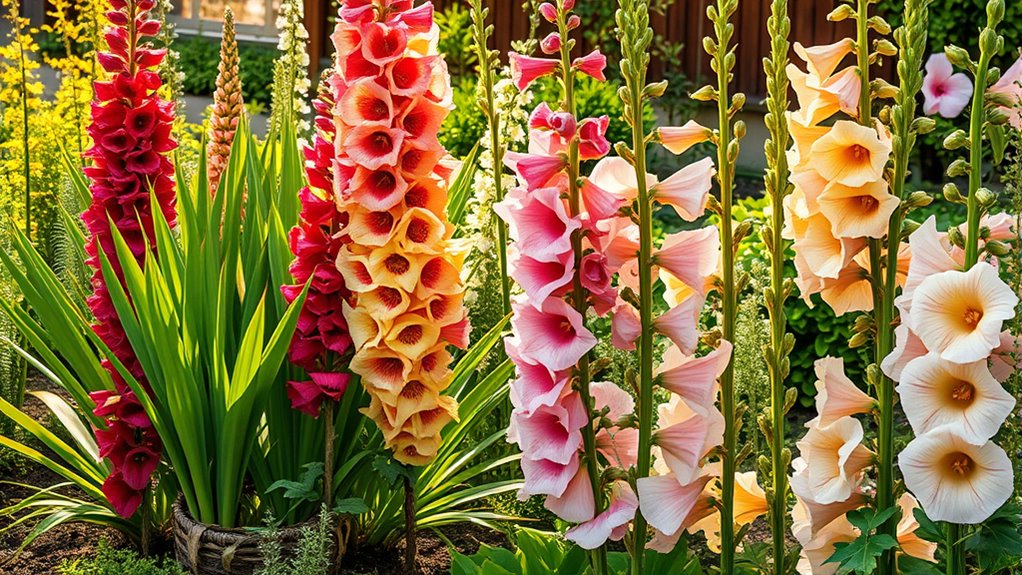
Understanding how hollyhocks and gladiolus reproduce helps you plan your garden better. You’ll explore different propagation techniques, like seed planting or bulb division, to expand your collection. Knowing their growth cycle stages guarantees you provide the right care at each phase for healthy blooms. Additionally, choosing the right propagation methods can influence how quickly and successfully your plants multiply.
Propagation Techniques Overview
Propagation techniques for hollyhocks and gladiolus vary depending on their growth cycles and preferred methods. To guarantee successful propagation, you should focus on key steps. First, select healthy bulbs or corms and prepare your soil with appropriate amendments to improve drainage and nutrient content. Second, when planting, use pruning techniques to remove damaged or diseased parts, promoting healthy growth. Third, for hollyhocks, propagate via seed sowing in early spring or by root cuttings, while gladiolus is best propagated through corm division or bulb offsets in late summer. Maintaining proper soil conditions, adjusting soil amendments as needed, and careful pruning will help your plants establish and thrive. Understanding these methods ensures a healthy start for your cottage garden favorites.
Growth Cycle Stages
Both hollyhocks and gladiolus follow distinct growth cycle stages that influence their propagation methods and timing. Hollyhocks develop from seed to mature plant over several months, producing tall spikes that add seasonal color to your garden design in summer. They go through germination, rosette formation, flowering, and seed production stages. Gladiolus, on the other hand, grow from corms, with a quick cycle that begins with planting corms in spring. They sprout, quickly develop leaves, bloom in mid to late summer, and then die back. Their growth cycles allow you to plan seasonal color effectively, with gladiolus providing rapid color bursts and hollyhocks offering tall, enduring blooms. Understanding these stages helps you optimize propagation timing and create a cohesive cottage garden design. Knowing the growth cycles of these plants enables better planning for seasonal blooms and garden aesthetics.
Compatibility With Other Cottage Garden Plants

Hollyhocks and gladioli can thrive alongside a variety of cottage garden plants, creating a lively and diverse display. When planning your garden layout, consider companion planting to enhance growth and aesthetics. Here are some good options:
- Lavender – attracts pollinators and deters pests, benefiting hollyhocks and gladioli.
- Echinacea – adds color and supports pollination, complementing taller blooms.
- Sweet Alyssum – fills gaps at the base, attracting beneficial insects and softening the visual height difference.
Mixing these plants promotes healthy growth and visual harmony, making your garden more inviting. Keep in mind that choosing the right companions helps prevent overcrowding and encourages better airflow, which is essential for maintaining healthy plants.
Common Pests, Diseases, and Troubleshooting
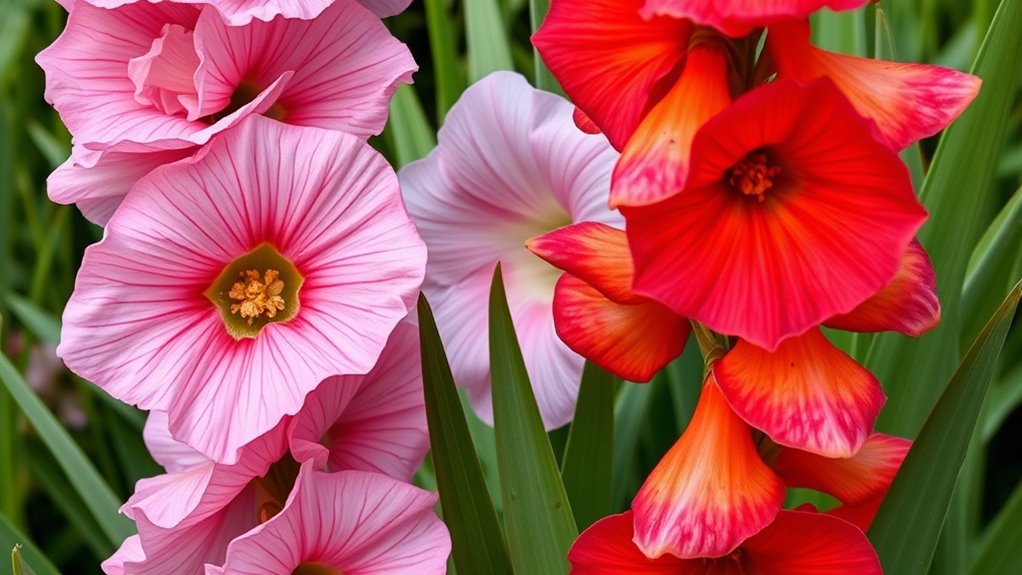
Despite their beauty, hollyhocks and gladioli are susceptible to a range of pests and diseases that can threaten their health. Common pests include aphids, beetles, and thrips, which can damage leaves and flowers. Diseases like rust, mold, and bulb rot also pose risks. To protect your plants, consider using pest resistant varieties when possible, as they offer added defense. Regular inspection and prompt removal of affected plant parts help prevent outbreaks. Implement disease prevention strategies such as proper spacing for airflow, avoiding overhead watering, and ensuring well-drained soil. Applying organic pesticides or neem oil can control pests effectively. Staying vigilant and practicing these strategies will help keep your hollyhocks and gladioli healthy and thriving throughout the season. Additionally, choosing pest-resistant varieties can provide an extra layer of protection against common issues. Incorporating proper plant selection based on disease resistance can further enhance your garden’s resilience.
Frequently Asked Questions
Which Flower Is More Drought-Tolerant?
If you’re choosing a drought-tolerant flower, gladiolus generally withstands dry conditions better than hollyhocks. Gladiolus offers vibrant flower color options and prefers planting at a depth of 4-6 inches, which helps conserve moisture. Hollyhocks, while beautiful, need more consistent watering. Consider your garden’s watering schedule and soil conditions, and remember that gladiolus is more suited for low-water environments due to its deeper planting depth considerations.
Can Hollyhocks and Gladiolus Be Hybridized?
You might wonder if hollyhocks and gladiolus can be hybridized. While they’re different species with distinct flower color options and growth habits, hybridizing isn’t typical. You’ll need to take into account their genetic compatibility, which is unlikely. For planting season tips, plant hollyhocks in early spring and gladiolus in late spring or summer. Focus on their unique traits to enjoy vibrant blooms, but don’t expect successful hybridization between these two garden classics.
Which Plant Attracts More Pollinators?
When considering pollinator preferences, hollyhocks generally attract more pollinators than gladiolus. Hollyhocks, with their large, open flowers, are excellent at attracting bees and other pollinators, making them ideal for encouraging pollination in your garden. Gladiolus tend to appeal more to butterflies. If your goal is attracting bees and supporting pollinator activity, planting hollyhocks is your best choice, as they’re more effective at drawing in these essential garden visitors.
Are Hollyhocks or Gladiolus Deer-Resistant?
You might wonder if hollyhocks or gladiolus are deer-resistant. Hollyhocks tend to be more deer-resistant, especially with their tall flower stalks and diverse flower color options, but they’re not completely deer-proof. Gladiolus, with fewer deer deterrents, can be more tempting for deer. When planning, consider planting season considerations and choose plants accordingly to minimize deer visits. Both flowers thrive in different seasons, so plan your garden accordingly.
How Do They Perform in Containers or Pots?
You’ll find both hollyhocks and gladiolus can thrive in containers, but their potted performance varies. Hollyhocks need tall, sturdy containers and consistent watering to support their height, while gladiolus prefers narrower pots with good drainage. For container growth, choose deep pots for hollyhocks to prevent toppling, and make certain gladiolus corms are planted shallowly. With proper care, both can add vibrant color to your patio or garden space.
Conclusion
Ultimately, choosing between hollyhocks and gladiolus depends on your garden’s needs. Both bring stunning beauty, but think of it like choosing between a towering lighthouse and a vibrant bouquet — each adds its own charm. With a little care, you’ll nurture these classics into focal points that enchant year after year. Remember, as the saying goes, “Where there’s a will, there’s a way,” so plant with passion, and your garden will flourish beautifully.
